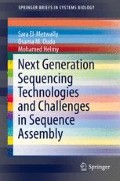Abstract
In the previous chapters, we described the most common and well-established next-generation sequencing technologies and platforms. However, several methodologies and sequencers with outstanding features have also been released in the last few years. Furthermore, additional technologies demonstrating great promise are currently in development. In this chapter, we will briefly describe these recent and ongoing developments that may have a profound impact on the future of sequencing.
Access this chapter
Tax calculation will be finalised at checkout
Purchases are for personal use only
References
Rusk N (2009) Cheap third-generation sequencing. Nature Methods 6 (4):244-245. doi:10.1038/nmeth0409-244a
Pushkarev D, Neff NF, Quake SR (2009) Single-molecule sequencing of an individual human genome. Nature Biotechnology 27 (9):847-850. doi:10.1038/Nbt.1561
Thompson JF, Steinmann KE (2010) Single molecule sequencing with a HeliScope genetic analysis system. Curr Protoc Mol Biol Chapter 7:Unit7 10. doi:10.1002/0471142727.mb0710s92
Harris TD, Buzby PR, Babcock H, Beer E, Bowers J et al. (2008) Single-molecule DNA sequencing of a viral genome. Science 320 (5872):106-109. doi:10.1126/science.1150427
Levene MJ, Korlach J, Turner SW, Foquet M, Craighead HG et al. (2003) Zero-mode waveguides for single-molecule analysis at high concentrations. Science 299 (5607):682-686. doi:10.1126/science.1079700
Eid J, Fehr A, Gray J, Luong K, Lyle J et al. (2009) Real-time DNA sequencing from single polymerase molecules. Science 323 (5910):133-138. doi:10.1126/science.1162986
Kasianowicz JJ, Brandin E, Branton D, Deamer DW (1996) Characterization of individual polynucleotide molecules using a membrane channel. Proc Natl Acad Sci U S A 93 (24):13770-13773
Schadt EE, Turner S, Kasarskis A (2010) A window into third-generation sequencing. Hum Mol Genet 19 (R2):R227-240. doi:10.1093/hmg/ddq416
McNally B, Singer A, Yu Z, Sun Y, Weng Z et al. (2010) Optical recognition of converted DNA nucleotides for single-molecule DNA sequencing using nanopore arrays. Nano Lett 10 (6):2237-2244. doi:10.1021/nl1012147
Stoddart D, Heron AJ, Mikhailova E, Maglia G, Bayley H (2009) Single-nucleotide discrimination in immobilized DNA oligonucleotides with a biological nanopore. Proc Natl Acad Sci U S A 106 (19):7702-7707. doi:10.1073/pnas.0901054106
Purnell RF, Mehta KK, Schmidt JJ (2008) Nucleotide identification and orientation discrimination of DNA homopolymers immobilized in a protein nanopore. Nano Lett 8 (9):3029-3034. doi:10.1021/nl802312f
Stoddart D, Maglia G, Mikhailova E, Heron AJ, Bayley H (2010) Multiple base-recognition sites in a biological nanopore: two heads are better than one. Angew Chem Int Ed Engl 49 (3):556-559. doi:10.1002/anie.200905483
Glenn TC (2011) Field guide to next-generation DNA sequencers. Mol Ecol Resour 11 (5):759-769. doi:10.1111/j.1755-0998.2011.03024.x
Glenn TC (2013) Field guide to next-generation DNA sequencers-Update. http://www.molecularecologist.com/next-gen-fieldguide-2013/. Accessed 10-01-2014
Oxford Nanopore Technologies Ltd. (2014) The GridION System. https://www.nanoporetech.com/technology/the-gridion-system/the-gridion-system. Accessed 10-01-2014
Collins FS, Hamburg MA (2013) First FDA authorization for next-generation sequencer. N Engl J Med 369 (25):2369-2371. doi:10.1056/NEJMp1314561
Hanna GJ, Johnson VA, Kuritzkes DR, Richman DD, Martinez-Picado J et al. (2000) Comparison of sequencing by hybridization and cycle sequencing for genotyping of human immunodeficiency virus type 1 reverse transcriptase. J Clin Microbiol 38 (7):2715-2721
Morey M, Fernandez-Marmiesse A, Castineiras D, Fraga JM, Couce ML et al. (2013) A glimpse into past, present, and future DNA sequencing. Mol Genet Metab 110 (1-2):3-24. doi:10.1016/j.ymgme.2013.04.024
Qin Y, Schneider TM, Brenner MP (2012) Sequencing by hybridization of long targets. PLoS One 7 (5):e35819. doi:10.1371/journal.pone.0035819
Di Ventra M (2013) Fast DNA sequencing by electrical means inches closer. Nanotechnology 24 (34):342501. doi:10.1088/0957-4484/24/34/342501
Ohshiro T, Matsubara K, Tsutsui M, Furuhashi M, Taniguchi M et al. (2012) Single-molecule electrical random resequencing of DNA and RNA. Sci Rep 2:501. doi:10.1038/srep00501
Bell DC, Thomas WK, Murtagh KM, Dionne CA, Graham AC et al. (2012) DNA base identification by electron microscopy. Microsc Microanal 18 (5):1049-1053. doi:10.1017/S1431927612012615
Helmy M, Tomita M, Ishihama Y (2012) Peptide identification by searching large-scale tandem mass spectra against large databases: bioinformatics methods in proteogenomics. Genes Genome Genomics 6:76-85
Ishii N, Nakahigashi K, Baba T, Robert M, Soga T et al. (2007) Multiple high-throughput analyses monitor the response of E. coli to perturbations. Science 316 (5824):593-597. doi:10.1126/science.1132067
Edwards JR, Ruparel H, Ju J (2005) Mass-spectrometry DNA sequencing. Mutat Res 573 (1-2):3-12. doi:S0027-5107(05)00023-0
Beres SB, Carroll RK, Shea PR, Sitkiewicz I, Martinez-Gutierrez JC et al. (2010) Molecular complexity of successive bacterial epidemics deconvoluted by comparative pathogenomics. Proc Natl Acad Sci U S A 107 (9):4371-4376. doi:10.1073/pnas.0911295107
Monforte JA, Becker CH (1997) High-throughput DNA analysis by time-of-flight mass spectrometry. Nat Med 3 (3):360-362
Howard R, Encheva V, Thomson J, Bache K, Chan YT et al. (2013) Comparative analysis of human mitochondrial DNA from World War I bone samples by DNA sequencing and ESI-TOF mass spectrometry. Forensic Sci Int Genet 7 (1):1-9. doi:10.1016/j.fsigen.2011.05.009
Greenleaf WJ, Block SM (2006) Single-molecule, motion-based DNA sequencing using RNA polymerase. Science 313 (5788):801. doi:313/5788/801
Pareek CS, Smoczynski R, Tretyn A (2011) Sequencing technologies and genome sequencing. J Appl Genet 52 (4):413-435. doi:10.1007/s13353-011-0057-x
Fujimori S, Hirai N, Ohashi H, Masuoka K, Nishikimi A et al. (2012) Next-generation sequencing coupled with a cell-free display technology for high-throughput production of reliable interactome data. Sci Rep 2:691. doi:10.1038/srep00691
Chen YJ, Roller EE, Huang X (2010) DNA sequencing by denaturation: experimental proof of concept with an integrated fluidic device. Lab Chip 10 (9):1153-1159. doi:10.1039/b921417h
Gurevich A, Saveliev V, Vyahhi N, Tesler G (2013) QUAST: quality assessment tool for genome assemblies. Bioinformatics 29 (8):1072-1075. doi:10.1093/bioinformatics/btt086
Author information
Authors and Affiliations
Rights and permissions
Copyright information
© 2014 The Authors
About this chapter
Cite this chapter
El-Metwally, S., Ouda, O.M., Helmy, M. (2014). New Horizons in Next-Generation Sequencing. In: Next Generation Sequencing Technologies and Challenges in Sequence Assembly. SpringerBriefs in Systems Biology, vol 7. Springer, New York, NY. https://doi.org/10.1007/978-1-4939-0715-1_6
Download citation
DOI: https://doi.org/10.1007/978-1-4939-0715-1_6
Published:
Publisher Name: Springer, New York, NY
Print ISBN: 978-1-4939-0714-4
Online ISBN: 978-1-4939-0715-1
eBook Packages: Biomedical and Life SciencesBiomedical and Life Sciences (R0)

